
News Update - December 2019
Engineering notes
The year began on a high with the movement of 82045 off its isolated length of track on to the railway and making its first run through Bridgnorth station, with the help of a diesel shunter and into the loco yard. Within a few weeks our loco was inside the erecting shop. The year draws to a close with both pony trucks approaching completion and all the components for the mechanical aspect of the brakes ready for fitting to make the handbrake operational.
The lubrication of the various moving parts of the pony trucks still has to be addressed before the trucks are installed under the loco. The method of the eventual installation has been a matter under discussion in recent weeks. It is likely that the trucks will be moved into the erection shop in a partially completed state and the final build with fitting of wheels and axleboxes undertaken indoors close to the loco.
In the machine shop nuts for the ends of the piston rods are in the course of manufacture although are not yet complete. The piston rods themselves are only partially machined.
Not all work in building a new locomotive is headline catching news. A glance at the photograph of the brake pull rods shows the fork ends with holes in them. Each hole requires a bush to be made to a slight interference fit and then pressed into the hole. A corresponding pin then has to be made to fit into the bushed holes, all time consuming and not very exciting work. A similar situation exists with the pony trucks. There is also much drilling and tapping of holes for fitting grease nipples on the pony trucks and the brake block hangers.
At some stage the water tanks will have to be temporarily fitted on to the loco in order to manufacture the balance pipe and make further progress with vacuum and steam heat pipework plus injector pipework. These pipe runs are clipped to the underside of the tanks as they progress forwards from the cab area.
As the attached photos show the longitudinal and transverse stays for the boiler/firebox have been forged and machined as have the first valve gear components, ie. the combination levers and union links.
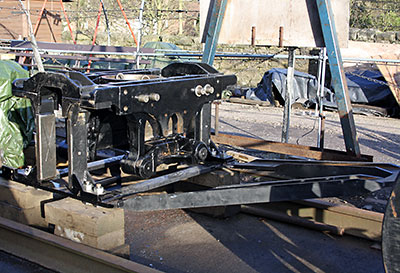
The rear pony truck assembly. Photo: Tony Massau.
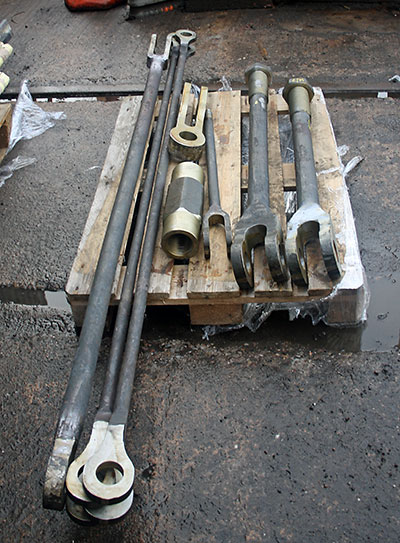
Recently delivered brake pull rods. Photo: Tony Massau.
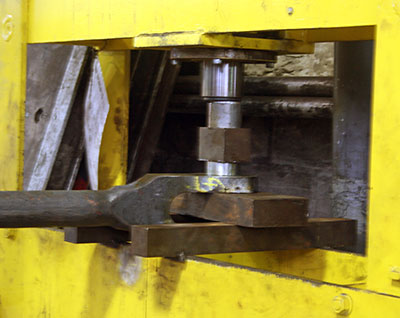
Pressing a bush into a hole in a fork end of a brake pull rod. Photo: Tony Massau.
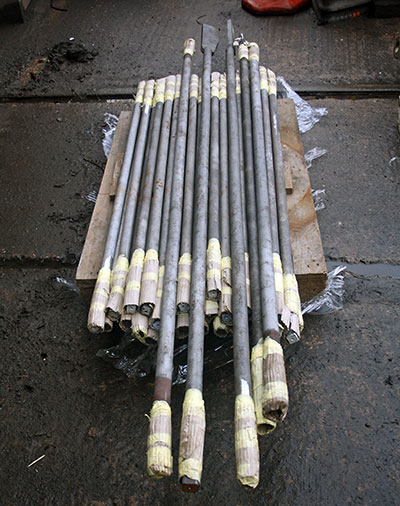
The forged and machined longitudinal and transverse stays. Photo: Tony Massau.
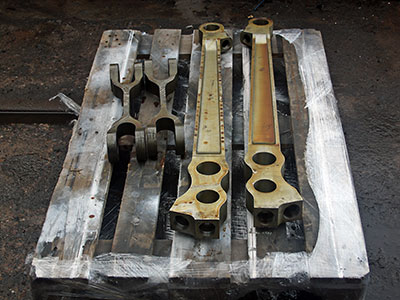
Valve gear components: combination levers & union links. Photo: Tony Massau.
82045 in 2019
Chris Proudfoot
Well, here we are again at the end of another year, with the Midwinter Solstice just around the corner and the season of tinsel and balls finding me, as always, hopelessly unprepared and wishing I could crawl away with my bowl of gruel, a la Ebenezer Scrooge, until it’s all over.
If you have been following the monthly updates on this website, you will know that 2019 has been a generally good year in the life of 82045. We started the year on a high note when the 0-6-0 wheeled chassis was moved undercover, for the first time, in a flawless operation engineered by our team working in conjunction with Allely’s Installations Ltd. We end it with work well advanced on the pony truck assemblies and braking system (our chaps are still occupying our draughty site opposite the Boiler Shop since there isn’t enough space in the shed for this work to proceed) and with the assembly of the boiler and firebox within sight. In this connection, Neil Taylor, SVR Bridgnorth Works Manager, has the following to say:
“...we are holding to start the boiler following the completion of the boiler for the Stanier Mogul. We would start sooner depending on the departure of the first two IOM boilers early next year. In the budget planning process 82045 is the mainstay of the contract boiler work for the next 18 months. I have not accepted any other significant work into the boiler shop and both space and resources will be dedicated to the Standard 3 boiler over the coming months. We have recently reviewed the component requirements and there are orders in place for long lead items. The plan will deliver a new boiler in the middle of 2021.”
Neil has consistently kept his word to us, and I know that my 82045 colleagues appreciate having such a professional – and approachable – SVR opposite number to work with. Having said this, Neil is working within the constraints of a steam railway heritage (don’t like that word but can’t think of a better one) industry in which demand increasingly outstrips supply, but we are confident that he will do his very best to fulfil his predictions: firstly because he is a top bloke, secondly because he knows what a money-spinner 82045 is going to be for the Severn Valley Railway.
Moving away slightly from our immediate preoccupations, you may have read a lengthy article in the latest issue of Steam Railway magazine which takes the form of an interview between David Wilcock and former SVR General Manager Michael Draper. I have known and liked Michael for a good few years, and he is always worth listening to. In this interview, he makes some very pertinent points about the future of the steam preservation movement but also refers less than enthusiastically to the idea of new build locomotives. To sum up:
1: Does a new build engine actually constitute “preservation”?
2: The current crop of new build projects – ours included – is only going to add to the existing problems of maintaining the country’s steam fleet when the time comes around for the first ten-year overhauls.
I originally wrote a longer piece in reply, but then thought, on reflection, that the annual 82045 news round-up was not the appropriate vehicle for this. I am, however, going to write a civilised riposte which I hope Steam Railway will publish in its “Mailbag” in a forthcoming issue. If any of you would like to add your own comments on the new-build phenomenon, and on what Michael has to say about it, please do get in touch with me and I will be very pleased to include, where possible, what you say, and of course to credit you in the letter in whatever way you wish.
So there we are for another year. I think you can be assured that 82045 is still on track for a first steaming in the last quarter of 2021 or the first quarter of 2022. In a fortnight, that means you will be able to say “next year” or “the year after next”, which doesn’t sound too far away. Just keep everything crossed!
Once again, I’d like to thank you all so much for your support, and, while I’m at it, to thank also our superb engineering team for their efforts. Speaking as someone with (alas) the engineering nous of a mentally-challenged frog, I can only look on in wonder at their expertise.
All the very best for the coming season and for 2020.
gaudeamus atque floreamus omnes